2012 Porsche 911 Carrera S. Click image to enlarge |
|
First Drive: 2012 Porsche 911
Manufacturer’s web site |
Review and photos by Greg Wilson
Photo Gallery:
2012 Porsche 911
You’ll notice that this is the same 2012 Porsche 911 Carrera S reviewed by Peter Bleakney a couple of months ago. But hey, it’s always nice to get a second opinion about the same car — especially if it’s a different opinion…
As Peter points out, the all-new 911 “is a much easier car to live with on a day-to-day basis”, but personally, I wouldn’t recommend it. The main problem is the 911’s stiff ride. On smooth blacktop it’s okay, but given the state of our roads these days—potholes, broken pavement, construction everywhere—the 911 rides like an oxcart, even though it features shocks that automatically adapt to different road surfaces.
And while it handles with rock-solid stability and tenacious grip, if it’s raining, the 911 Carrera S’s extremely wide summer tires—my car had Pirelli P Zero P245/35ZR20-inch (front) and P295/30ZR20-inch (rear) performance tires—tend to hydroplane through standing water. And in the dry, these tires are quite noisy.
2012 Porsche 911 Carrera S. Click image to enlarge |
As well, the 911 is such a low car—even lower than the previous 911—that getting in and out can be a chore, especially for the older demographic that has the money to afford one of these cars. On the road, the 911 is so low that other drivers (mostly pickup drivers) can’t see you when changing lanes, making for some nerve-wracking brake-and-avoid manoeuvres. And finally, engine noise from the 911’s 3.8-litre flat six positioned behind the cabin is louder than in most cars, particularly when the driver-selectable sport exhaust is activated in Sport and Sport Plus mode. Yes, you’ll enjoy the engine’s snarly growl for a while, but it gets tiring on long trips.
Oh, and the new automatic start-stop system, which turns off the engine when stopped and restarts it when the brake pedal is released, becomes a repetitive assault on the senses each time it starts in stop-and-go traffic, and seems inappropriate in a 400-hp, 300-km/h sports car. (Yes, I know it helps the environment, but if a 911 owner wants to help the environment they can buy a Panamera Hybrid.) Fortunately, there’s a button to deactivate it.
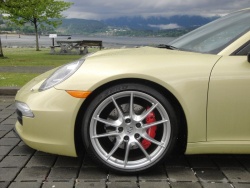 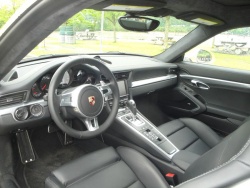 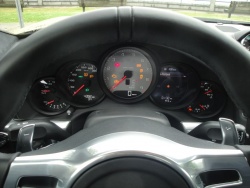 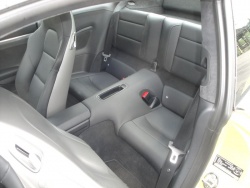 2012 Porsche 911 Carrera S. Click image to enlarge |
There’s one other less obvious downside to the 911: the high cost of even minor repairs. You’ll find yourself vainly searching for a downtown parking spot where there isn’t a risk of someone opening their car door and dinging your expensive bodywork. And the 911’s low front end? Meet your nemesis, the concrete parking stall curb! Don’t ask me about the price of Porsche parts and service; you don’t want to know.
Now that I’ve got those negatives off my chest, let me tell you what you’ll enjoy about the new 911. First, it looks great. Though it’s obviously a 911, its new longer, lower and wider shape draws admiring glances and second takes from other drivers and pedestrians. It’s an impressive looking car that will certainly enhance your street cred—as it should for the as-tested price of $146,000.
Inside, the new interior design, materials, and workmanship are of particularly high quality. Controls are user-friendly once you get used to the location of all the buttons. The optional 18-way front sport seats (part of the $5,080 Premium Package) have a multitude of power adjustments to suit your individual body frame and keep it comfortable and in place during high-speed cornering. A wealth of driver information is available from the standard centre navigation system and driver information gauge in the instrument cluster. As well as navigation, telephone, audio and traffic info, the centre screen offers trip info like fuel range, travel time, average fuel consumption, instantaneous fuel consumption, average speed, travel time, and distance to empty. The round display on the right of the gauge cluster also includes digital displays for coolant, oil temperature, and oil pressure, a real-time g-force meter, tire pressure indicator, and a Sport Chrono stopwatch that connects with the dashtop chronometer, should you be timing your laps at Mosport or Circuit Mont-Tremblant.
My only complaints with the interior are that there is no centre console storage box, the gauge numerals are a bit small for easy viewing, and the flip-out cupholders on the passenger side are completely useless.
As expected in a 911, the two rear seats are difficult to get in and out of and rather uncomfortable, but two adults can fit in there, when necessary. And when not needed, the rear seatbacks fold down to create a large storage area behind the front seats, which makes up for the rather small trunk under the hood.
Unlike early 911s, the 2012 911 caters to all kinds of drivers, no matter what their skill level. Three driver-selectable driving modes provide three different levels of performance. Feel like leisurely cruising around town, maximizing fuel economy? Leave it in the default Normal mode. Want a little more throttle response, better acceleration, firmer suspension and steering, and quicker shifts? Press the Sport button on the centre console, which also activates the snarly Sport Exhaust System. Feel like heading to the track for a day of hot laps? Press the Sport Plus button and the 911 comes alive with high-revving shifts, stiffer shocks, quicker steering and looser restrictions on the stability control system.
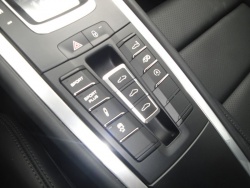 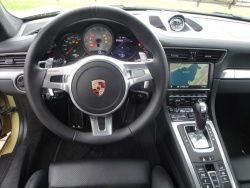 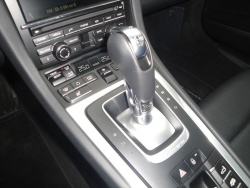 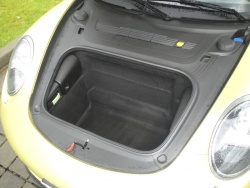 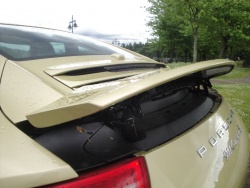 2012 Porsche 911 Carrera S. Click image to enlarge |
A feature of the optional Sport Chrono Package and Sport Plus mode is Launch Control: with the PDK tranny in ‘D’ or ‘M’, the driver depresses the brake pedal with their left foot and the accelerator all the way to the floor with their right foot. When the engine torque rises to maximum level, a “Launch Control Active” display lights up in the instrument cluster, and the driver releases the brake pedal for maximum acceleration without burning out the rear tires or slip-sliding all over the place. With Launch control, 0–100 km/h can be achieved in just 4.1 seconds. Of course, other than at the track or a drag strip, there are few places where you could actually do this and not attract any unwanted attention.
Still, whether you’re a commuter, an enthusiast, or a racer — or all three — the new 911 has the ability to adapt to different driving styles and skill levels (as long as you can put up with the aforementioned downsides).
The new 911 is packed with active safety features designed to keep good and bad drivers out of trouble. A combination of traction and stability aids automatically rectifies common driving errors and compensates for changing road surfaces. Should you understeer or oversteer, Porsche Stability Management (PSM) calculates the intended direction of travel and automatically brakes individual wheels to bring the car back into line. It also uses Anti-Slip Regulation (ASR), Automatic Brake Differential (ABD) and Engine Drag Torque Control (EDC) to minimize traction loss under acceleration, and pre-charges the brakes if you suddenly release the gas pedal. It also minimizes stopping distances using Anti-lock Brakes (ABS) and Brake Assist. Combined with Porsche Active Suspension Management (PASM) that automatically adapts the shocks to different road surfaces, Porsche’s Dynamic Chassis Control (PDCC), an active anti-roll system for reducing lateral body movement when cornering, and Porsche Torque Vectoring Plus (PTV), an electronically controlled rear differential that sends more torque to the outside rear wheel when cornering, the new 911 is the safest 911 yet—despite a basic vehicle design that is rear-heavy with extremely wide (11-inch) rear tires.
Though some of these features can be turned off, Porsche has obviously decided that active safety must be the default mode regardless of whether it now takes less driving skill to pilot a 911. That’s probably a prudent philosophy since government authorities don’t require any special high-performance driving courses for people who purchase high-performance cars.
The 911 Carrera S’s 400-horse 3.8L flat six (up from 385 in 2011) lets out a lusty growl and has plenty of torque, but as mentioned, the Normal driving mode keeps throttle response sedate and performance surprisingly “normal”. I preferred Sport mode for its quicker off-the-line acceleration and highway passing throttle response that were more in keeping with the car’s character. But I found Sport Plus mode too aggressive for street driving, as shifts occur at unnecessarily high engine revs, creating more engine noise while sucking back more fuel.
The PDK seven-speed dual-clutch transmission is really superb, either in automatic or manual mode. Automatic shifts are quick and smooth—quicker than a driver can shift a manual transmission—occurring at different revs depending on the driving mode selected (Normal/Sport/Sport Plus) and the level of driver aggressiveness. The big steering wheel paddles are easy to grip and in Sport Plus mode, you’ll really feel like a race-car driver. I didn’t have the opportunity to test the new seven-speed manual transmission.
Of course, these days a quick burst down any side street will have every cell phone-packing do-gooder texting your licence plate number to the local gendarmerie. As with most high-performance road cars, there are few places where you can legally exploit the 911’s capabilities. If you’re going to buy a new 911, sign up for weekend hot laps at your local racetrack, sign the waiver, and get out there and really enjoy the car. Otherwise, there are plenty of other cars you can buy for a hundred grand that will give you a better combination of performance, comfort, and status—on a day-to-day basis.
|
Pricing: 012 Porsche 911 Carrera S
Specifications
Competitors
Crash test results
|











